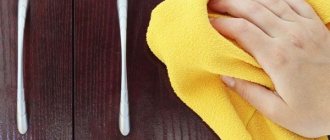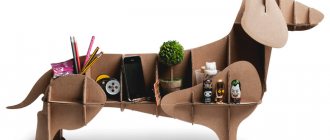Leather furniture looks rich and beautiful. Such sofas and armchairs speak of respectability and good taste.
A beautiful leather sofa is suitable for classic interiors and office settings.
In addition to visual beauty, leather interior items are wear-resistant, and only one detail can mar the happiness of owning a sofa: a cat can scratch it. “Don’t feed the claw-scratchers bread” - let them sharpen their claws on the furniture. We will tell you in our material how to save a leather sofa from furry pests and scratches.
Cat claw marks on upholstered furniture
Leather upholstery repair kit
Crime and Punishment
Damage to leather upholstery
Is it possible to talk about measures to punish a pet? No. This is not worth doing. The cat will not be able to realize his guilt. The instincts of fluffies are such that their very nature contains the desire to sharpen their claws, marking their territory. The best solution to sharpening your cat's claws is to place a scratching post in your house: this will save the furniture from scratches.
A scratching post with a post for your cat is perfect for her scratching and will leave your furniture intact
Such items are relatively cheap and are sold at any pet store. If you don’t want to buy a scratching post, make one yourself by wrapping hemp thread around a board and attaching the structure to the place where the cat usually sharpens its claws.
Homemade scratching post with shelves
How to buy a cat?
If you are interested in whether there are “well-bred” cat breeds in the world, then we have to disappoint you - alas, there are none. But there are some practical tips that will help you when buying a pet:
- buy a three- or four-month-old kitten (the character is already indicated, and the owners probably taught him to use a scratching post);
- give preference to breeds that are focused on communicating with people (for example, British Shorthair) to make it easier to achieve mutual understanding;
- In terms of neatness, a purebred cat can surpass even the most purebred “competitors . But here it is better to purchase an already adult pet, so as not to buy, so to speak, a pig in a poke.
5/5 (7)
Saving a sofa with oil
Wet the sofa with oil and then polish it well
If the scratching post was not purchased on time, and the pet managed to get to the leather sofa, sharpening its claws on it and leaving scratches, read about how to save the furniture. For restoration work you need to stock up on the following supplies.
| Oil | Tampons | With a rag |
| For wetting | For wiping | For polishing |
- You can wipe a very small damaged area of leather on the surface of the furniture.
- Check carefully for any changes to the upholstery. If no changes are found, wipe the cat's scratches and the areas surrounding them.
- Using a rotating motion, rub the oil into the sofa. You will need to wait half an hour and see what you get.
If the cat scratched the sofa shallowly, the traces of the cat’s crime will disappear after the first manipulation with the oil. But if the traces lie deeper than expected, the steps described above will have to be repeated three to four times.
Making a scratching post with your own hands. Master Class
Let's look at one simple and inexpensive way to make a cat simulator. To do this, prepare in advance:
- a round wooden plate (ø35 cm), cut it out before starting work;
- tape (yellow, pink or white);
- wooden beam (40x40 mm) 0.7 m long;
- scissors;
- electric drill, screwdriver, and wood screws of sufficient length;
- glue, construction stapler;
- white cover (40x40 mm), these are used for switches;
- white paint;
- nylon rope (50 m);
- fabric dye (yellow or pink).
A beautiful scratching post made from scrap materials
Step 1. After preparing everything you need, you can start making your own scratching post. First, secure the beam in the center of the base. It is important to accurately determine the center of the circle, otherwise the appearance of the entire product may be spoiled. After fixing, paint the circle with white paint.
The post is attached to the center of the base
Step 2: Start painting the rope. By the way, this rope is lighter in color and therefore better than sisal or jute. Although nylon itself is less durable, this is not so important - scratching posts do not last very long, their service life (both homemade and purchased) is limited.
Painting nylon rope
Step 3: When dyeing, follow the instructions that came with the fabric dye. Then the rope should dry thoroughly, for which it can be laid, for example, on a radiator. This may even take the whole night, so it is better to postpone further work until the next morning. Moreover, during this time the smell of the paint with which you painted the round base will have time to disappear.
The rope must dry well
Step 4. You can start winding. To begin, nail one end of the rope to the block, as shown in the photo below. Also be sure to spread the glue all over the post. If you use ropes of different colors, connect them using colored tape (pink on the pink area, etc.). Seal the joint between pink and yellow with pink tape, which will look like a continuation of the pink edging. This is why you don’t need to buy tape in all three colors.
The post is wrapped with rope
Step 5. Secure the second end of the rope on top with the same stapler, and cover the remaining area with a plastic cover. In the absence of the latter, simply paint the area or decorate it as you wish.
The remaining area is covered with a lid
Step 6. The scratching post is ready for use! If you don’t have the time/energy/desire to make this option, you can try making another one (step-by-step instructions are given below).
Photo of the finished scratching post
Table. Making a scratching post from corrugated cardboard.
| Steps, photo | Description of actions |
| Step 0 | To begin, prepare everything you need - thick corrugated cardboard, a screwdriver, a template with diagrams of all levels of the future design, an electric drill, a wooden dowel, a knife for cutting cardboard, screws, plywood, as well as a convenient surface on which you will cut the levels. |
| Step 1 | Mark the center of the plywood base. Take a drill and, placing plywood between a pair of chairs, drill a hole at the mark. |
| Step 2 | Next, using the same drill, drill a hole in the center of the dowel, as shown in the image. This hole will make the next step much easier for you. |
| Step 3 | Take a screw, screw it into the board, and then screw the wooden dowel to the plywood base. Holding the screw with a screwdriver, take the dowel with your other hand and screw it (the screw) to it. It is important to hold the dowel until it is screwed tightly. Manually screwing in the dowel allows you to control the process and, as a result, fix the element straight. |
| Step 4 | Start cutting out the templates. Prepare in advance and then print out templates for all seven levels of the future product. Templates should be drawn on cardboard and cut out. |
| Step 5 | Take the templates and use them to draw shapes on the corrugated cardboard. |
| Step 6 | Cut out the layers along the contour. Using a knife, use a knife to cut out the cardboard using the drawn outline. It is important that the knife you use is sharp, otherwise you may damage the cardboard. |
| Step 7 | Start assembling all layers. Stretch the cut cardboard layers one by one onto a wooden dowel. There is no need to glue the layers together - this will allow you to replace one of them in the future if damaged. |
As a result, you will get something like this scratching post. As you can see, there is nothing complicated here; the work can be completed in just a couple of hours.
DIY scratching post for cats
Below is another interesting option - a small claw in the shape of a fish . Although you can choose any other shape. The idea is to cut corrugated cardboard into strips 10 cm wide and gradually wrap them around each other. However, all stages of production are shown below.
DIY scratching post in the shape of a fish
Another life-saving measure
You can save furniture with olive oil
Buy olive oil and apply it to the scratches. Cover these areas with a cotton cloth and wait until the oil is absorbed. You will need to cover the structure with a cloth and use a lukewarm iron. The device should be kept on the fabric for no more than ten seconds.
There is one caveat to this method of saving a sofa from cat scratches: you can’t just take the iron and place it on the fabric. This will ruin the leather upholstery of your furniture. You should move the device in a circular motion over the fabric until the oil is completely absorbed.
Save with shoe polish
Minimal color palette for shoe polish
The shoe polish should match the color of the leather sofa. Didn't find the shade you're looking for? Buy similar colors and achieve the desired color by mixing creams. This method only applies to shallow scratches on the sofa. You can take a small amount of shoe polish and apply it to the damage.
There is a wide range of shoe polish colors available from different manufacturers.
If the color of the cream is chosen correctly, you will be able to perfectly disguise scratches on the surface of the sofa. If you are unable to choose the color of the cream, apply it to those areas of furniture with damage that are not very noticeable.
Leather paint in different release forms
Sketched background of the sofa with cream, suitable color
How to protect furniture from cats
You can't cover cabinets and bedside tables with covers. Polishes that mask scratches do not repel cats. If your pet has unloved smells, such as onions and garlic, it makes sense to apply juice to its favorite places.
Tip: Test how the furniture coating reacts to juice in a small, inconspicuous area. Some coatings, polishes and paints become brighter or, conversely, fade.
Spraying with a homemade product also helps. It is important not to pour too much water here: once it gets into a scratch, the wood will swell. Another option: wipe the surfaces with a strong infusion of herbs that smell to cats.
Ready-made Anti-Claw sprays do not wean the owner off a habit that is harmful to the owner, but drive cats away from their favorite place. If you combine use with a scratching post at the same time, the animal will retain its instinct. This way the object will be replaced without stressing the cat or damaging the furniture.
If a cat sharpens its claws on the sofa, the upholstery of the chair is hopelessly damaged - take a closer look at the fabric with the “anti-claw” property. Anti-vandal fabric for upholstery of upholstered furniture is easy to care for, does not pill, and is resistant to the claws of pets.
Pile is woven or glued into the knitted base, resulting in:
- furniture velor;
- velvet;
- imitation matting;
- pattern of leather, linen, denim or canvas.
A large selection, prints and various shades allow you to choose upholstery to replace the damaged one. Spraying the fabric after repairs with anti-claw spray can keep sofas and armchairs intact.
Soft plastic attachments for cat claws, if put on correctly, do not bother the cat. Although they look like abuse of an animal, they will not scratch the furniture or damage the upholstery. The method does not stop you from sharpening your claws. Let's apply as a temporary measure:
- during overexposure;
- before the final move to the village, where the cat will leave marks on the trees, and not on the door frame.
To protect furniture, use protective covers made of fabric or thick oilcloth. It is easier to treat them with repellents without damaging the wooden surface.
While raising a pet is in full swing, it is worth rearranging and locking especially valuable things (antique furniture, leather sofas) in another room with a key. As soon as the cat stops tearing up furniture, things will return to their place.
We use rubber-based glue
Rubber glue (rubber) is a solution of rubber in gasoline
Use rubber glue, liquid leather. Rub them into the scratch and let the product dry. When the scratch is sealed, paint over the damaged area on the sofa with a special paint that matches the color of the leather furniture.
Glued and painted over scratch on a green leather sofa
There are many products that can mask scratches on a sofa. Fortunately, people in Russia have a developed imagination. Some use markers, others use nail polish, others use wax and liquid skin.
Filling in small skin defects with a pencil
Renewing leather upholstery using affordable products
These methods are equally good and easy to use. Don’t despair ahead of time if your cat has done some mischief in the house, you know what to do!
Sofa cushion with a lot of scratches
Thorough cleaning of leather surfaces with a very gentle and effective product
Thorough grinding and repair of scratches with special compounds
Painting the leather, then final varnishing and an excellent repair result in the end
Restoration methods
There are several ways to restore leather sofas after they have been damaged by pets:
- oil grout,
- use of “liquid skin”,
- applying a patch or decorative applique.
The method is selected depending on how badly the leather surface is damaged.
Oil grout
If the scratch marks are fresh and shallow, you can restore a leather sofa cover using olive oil. This is done like this:
- Using a cotton pad, gently rub the oil into the scratched areas and areas around them.
- After rubbing, the surface is left to dry completely.
This is quite enough to disappear small scratches, but if traces remain, the procedure must be repeated.
To improve absorption, it is recommended to cover the lubricated surface with a napkin and lightly iron it with an iron turned on to the minimum heat setting.
Oil grout
Using oil will help restore the covering of a leather sofa if the damage is not significant and the scratches are shallow and fresh. The grouting process does not present any particular difficulties. Use a cotton pad to gently rub the oil into the damaged areas and leave until completely dry. The procedure can be repeated if traces remain. For a better effect, you can iron the surface covered with a napkin with a low-heat iron. I would like to note that the iron should only be used for products made of genuine leather; repairing leatherette does not require heat treatment.
Application of “liquid skin”
“Liquid skin” will help cope with more serious damage. It comes in a convenient aerosol form. Before use, it is advisable to clean the area of furniture from dirt and degrease it. Apply the liquid in an even layer and cover with a cloth, after which it is also recommended to warm up the area with a warm iron. This type of repair allows you to disguise fairly large scratches.
Patches and applications
What to do if the furniture is not just scratched, but also torn to shreds? The most basic option is reupholstery, but this is not always available, so patches or appliques can help out in this situation. You can use a patch on inconspicuous places on the sofa. It is recommended to glue it with special furniture glue or sew it on.
But if the back, seat or armrests of the sofa are damaged, you cannot do without an application. In this case, you can use pieces of leather fabric that contrasts the color of the sofa. From them we cut out various shapes that suit the decor in your room, and stick them not only on damaged areas of furniture, but also as decoration.
Why do cats scratch furniture and wallpaper?
Stopping a cat from sharpening its claws on furniture and tearing wallpaper to ribbons is a real challenge. A pet treats a person as a representative of its species, trying to prove its high family status. Cats sharpen their claws not because, like fashionistas, they are dull and require cosmetic intervention.
Reasons include:
- If poorly cared for, the cat will scratch the wallpaper to clean its claws. It’s a fungus, or debris has accumulated between the fingers; the instinct of a predator, sitting in ambush for a long time, requires cleanliness.
- The cat is tearing up the sofa to mark its territory, just like urine. Moreover, the higher the “traces of crime”, the higher the rank of the cat. Torn wallpaper on the wall serves as a visual indicator: “This is my territory!”
- Another reason is resentment. Cats are emotional animals. They get offended if there is no proper attention and affection. Imposingly approach the chair and demonstratively tear the upholstery with your claws... There was no need to ignore it when he was caressing. Attention and catch-up are guaranteed.
- Furniture brings into the room a barely perceptible smell of building and finishing materials. But not for cats. If an animal intends to turn the closet into sawdust, perhaps it’s a matter of “ambergris.” The furniture is expensive, but your pet also runs the risk of getting sick.
But tearing up wallpaper for the sake of exercise is the fantasy of the authors of texts on “cat” sites. Cats are not interested in waist size. Better sleep for another hour.
How to stop a cat from scratching furniture?
A separate issue is raising your animal. How to stop him from sharpening his claws on your furniture? You can purchase a special liquid at a veterinary store that repels cats. This composition should be used to saturate the furniture in those places where the cat likes to misbehave. There is also a composition that, on the contrary, attracts the cat’s attention, and it needs to be applied to the scratching post. Well, most importantly, devote more time to your pet, maybe he is just trying to attract attention with his pranks.
What do you think? Maybe you have your own ways to save your favorite furniture?
How to train
It’s one thing to simply make a scratching post, and quite another to force the cat to use it, leaving the furniture, wallpaper and other interior elements alone.
I will give some tips on this matter:
- To begin, place the sharpener near the places where the cat scratches furniture or wallpaper. When he sees the scratching post and starts using it, gradually move it away from its original place, moving it to where you need it;
- Show me what to do with this thing. Scratch it yourself with your hands, apply the cat’s paws. Let him feel the material, catch on the threads;
- Encourage the animal if the cat begins to show interest in this item;
- At the same time, do not forget to use methods to wean him off furniture, etc.
Do you have a cat? Was the problem of furniture damage a pressing issue, or did the animal initially only scratch what you allowed? Share your experience in the comments.
Thanks to everyone who reads us! Subscribe, leave comments and ask questions! We will be happy to answer them.











